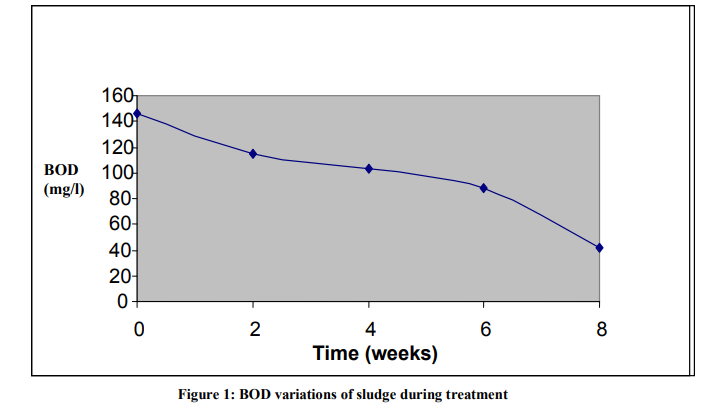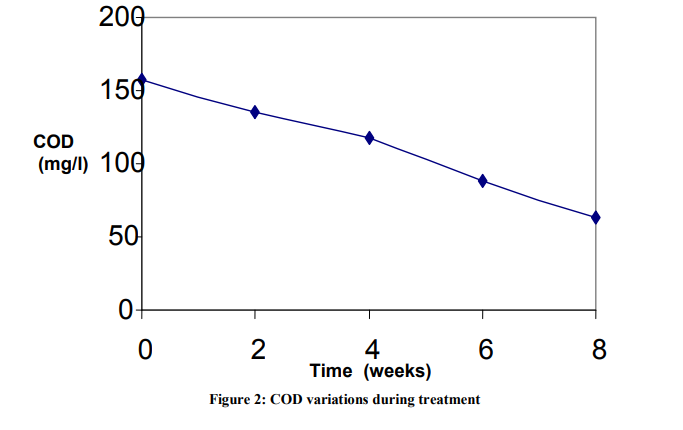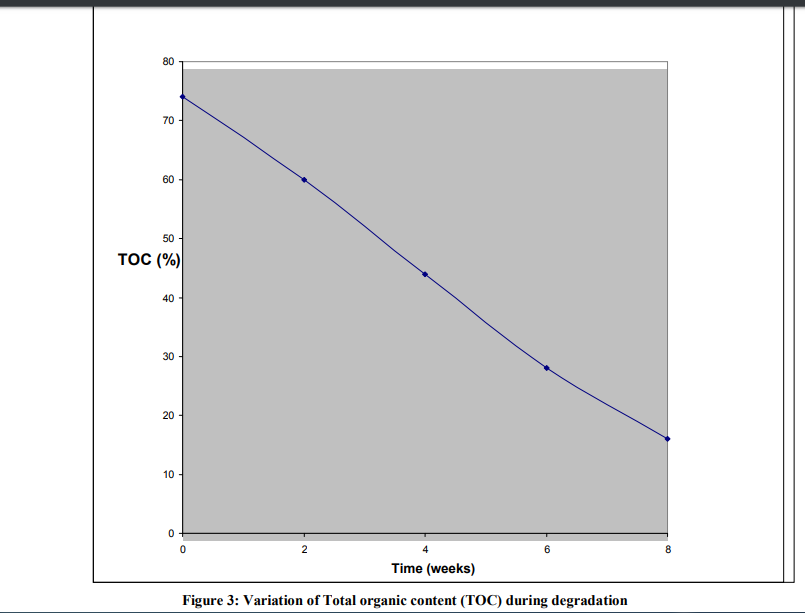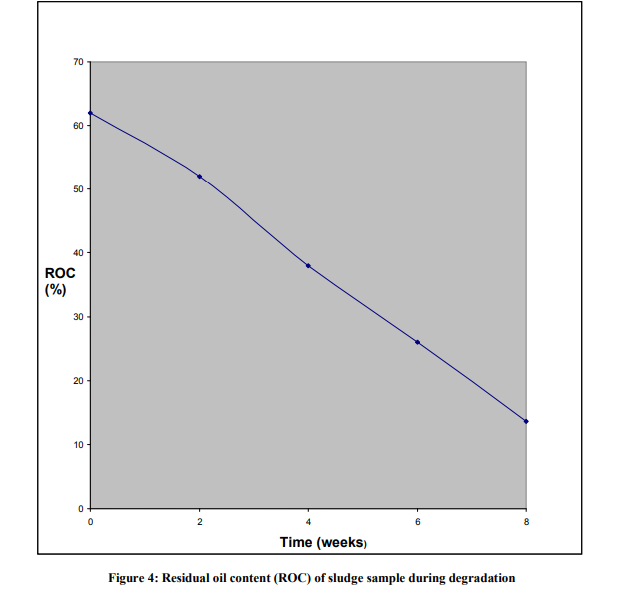IJCRR - 5(8), April, 2013
Pages: 126-135
Date of Publication: 25-Apr-2013
Print Article
Download XML Download PDF
ENHANCED BIODEGRADATION OF HYDROCARBON SLUDGE USING CONSORTIUM OF MICROORGANISMS
Author: Adeeyo Opeyemi A., Ayoola Ayodeji A., Efeovbokhan Vincent E.
Category: Technology
Abstract:In this work, the effects of consortium of Microorganisms, Pseudomonas purida, Pseudomonas aeuniguma, Pseudomonas florescence, and Bacillus megaterium, in degrading hydrocarbon sludge from refinery wastes, in Niger Delta area of Nigeria, have been studied. Focus is particularly on reduction of BOD, COD, TOC and ROC of the hydrocarbon sludge to comply with standard requirement for disposal. The organisms were maintained in nutrient agar plants and subculture on weekly basis throughout the period of investigation. Lab-assay method was used to carry out the experiment, i.e, Ex-Situ treatment. The sludge was inoculated with the consortium of Microorganisms and samples were taken for analysis at two week interval for a period of eight weeks. Result shows that, for the duration of investigation, there was 71.3% reduction of the initial BOD, 60.0% reduction of the initial COD, 78.4% reduction of the initial TOC and 78.1 % reduction of the initial ROC. It was noted that given enough time the consortium of Microorganisms has the potential to biodegrade the hydrocarbon sludge to an acceptable level of the Environmental Regulatory Body's standard. The sludge however requires more than eight weeks for the toxic level to be reduced to Regulatory Body's standard. It was also observed that the rate of biodegradation of the sludge by the Microorganisms declined with time.
Keywords: Biodegradation, Hydrocarbon sludge, Consortium, Microorganisms
Full Text:
INTRODUCTION
The production and subsequent storage and transportation of petroleum and its refined products have resulted in generation of large volume of oil (hydrocarbon) sludge. Hydrocarbon sludge is the residue or waste material from the oil industries. The oil sludge contains crude oil, water and petroleum solid particles. It is a pitch of messy mix of oil mixture of low and high molecular weights, sand and some inorganic materials(1) . The hydrocarbon sludge enters the environment by way of leakage or spillage from petroleum pipes or tanks, sediments obtained from storage tanks or tankers which are disposed off and from drilling wastes generated in the exploration and production of crude petroleum. The improper management of this sludge results in enormous environmental pollution and degradation. There has been a lot of advancement in the use of microorganisms for the destruction of chemical pollutants. These various technologies rely on the biodegradative activities of microorganisms, and they focus on enhancing existent but slow biodegradation processes in nature or technologies that bring chemicals into contact with microorganisms in some type of reactor that allows for rapid transformation (2) (3) (4). Oil degrading microorganism are ubiquitous and they naturally biodegrade numerous contaminating petroleum hydrocarbon, thereby cleansing such environment of pollutants(5) (6) (7) . The hydrocarbon sludge contains high level of environmental pollutants. The surface waters, underground water and the water table are polluted by the sludge. When the sludge find its way to a body of water it results in improper penetration of light and competition for oxygen by aquatic life thus causing large massive fish kill (8). This sludge pollutant equally gradually destroys coral reefs, coastal ecosystem and vegetation when discharge directly unto them or through percolation or otherwise (9) (10) (11) . The practice of indiscriminate dumping of the sludge generated from the oil prospecting, production and transportation, without treatment, poses a great health hazard and doom to the neighboring ecosystem and ultimately to man. Although there are occurrences of oil spillages whereby hydrocarbon sludge is adventitiously added to the environment, unused hydrocarbon sludge that can be controlled is however also dumped into the environment without treatment. One importance of development of better technologies is because of huge money required for clean-up. This study therefore focuses on reduction of the level of the toxic constituents, i.e. its toxicity, to an acceptable level such that when the sludge is afterwards discharged unto the environment it is neither inimical to man nor the ecology.
MATERIALS AND METHOD
Sample collection:
sludge sample was collected from disposal unit of Warri refinery, Nigeria, where sludge has been deposited for years. The sample was thereafter transferred to the laboratory for biodegradation process and analysis of its effluent sample. Microorganisms: The consortium of four microorganisms used for the biodegradation experiment was grown in the culture collection unit of the department of Biotechnology, Federal Institute of Industrial Research, Oshodi (FIIRO), Nigeria. The microorganisms are Psedomonas purida, Psedomonas aeuniguma, Psedomonas florescence and Bacillus megaterium. The organisms were maintained in nutrient agar plants and subculture on weekly basis throughout the period of investigation. The choice of these organisms was based on their ability at enhancing the process of degradation of effluents and sludge samples and thereby enhancing the process of biodegradation.
METHODS
The isolates were grown on minimal salt medium for increase in their biomass. 500ml of the sludge sample was asceptically introduced into 100mls of erlemeyer beaker. This was then autoclaved at 121 for 15 minutes. The autoclaved medium was then inoculated with the consortium of microorganism. The inoculated sample was left in the laboratory for a period of 8 weeks at room temperature (28 2 ) ? . At fortnight intervals, analysis of the sludge sample was carried out in order to monitor the level of degradation in the sample. Analysis was carried out to determine the Biochemical Oxygen Demand (BOD), Chemical Oxygen Demand (COD), Total Organic Content (TOC) and Residual Organic Content (ROC) at two weeks interval The experimental procedures and methods used for the determination of these parameters are given below:
Determination of the physiochemical properties of the sample Temperature:
The temperature of the sludge sample was determined with the aid of mercury bulb thermometer. Determination: The was determined with the aid of a previously standardized meter (Unicam 0 945 model). The meter was calibrated using 4.0 and 7.0 buffers.
Biochemical Oxygen Demand (BOD) determination
Two BOD bottles were filled during each analysis with the sludge sample. The bottles were stoppered tightly. One of the bottles was placed in the incubator at 20oC . The dissolved oxygen ?D1 ? of the sample in the other bottle was determined as described: 2mls of manganese sulphate solution was added to the sample followed by 2mls alkaline iodine reagent below the surface of the liquid. The solution was then mixed carefully and the precipitate allowed to settle, leaving a clear supernatant above the manganese hydroxide floc and later shaken again. 2mls of concentrated sulphuric acid was added and allowed to run down the neck of the bottle. The bottle was then re-stopperred and mixed by gentle inversion until dissolution was complete. 100 mls of the sample was taken for the BOD bottle and titrated with 0.025N sodium thiosulphate solution to a pale straw yellow colour. I ml of starch solution was added and the titration continued to the appearance of the blue colour (12) .
The dissolved oxygen in mg l referred to as ? 1 ? was then calculated as follows:

After the incubation period of 5 days, the dissolved oxygen ? 2 ? of the incubated sample was determined in the same manner as above. The BOD of the sludge was then calculated as: BOD ?mg l? = 1 - 2
Chemical Oxygen Demand (COD) determination
The chemical oxygen demand was determined as follows: 100mls of the sample was measured into a measuring cylinder. This was later mixed with 5ml of sulphuric acid (1:3). The mixture was then heated quickly to boiling point. 15.0cm3 of 0.01M potassium permanganate solution was quickly added into the boiling mixture and left for ten minutes. Thereafter oxalic acid (0.01M) solution was added. Two drops of permanganate solution was used as the indicator and thereafter (0.01M) solution was used for the titration to a noticeable pink colour. COD was calculated as:

Total Organic Content (TOC) determination
This was done by weighing out 10g of the sludge sample into a known weight of beaker. Thereafter, the sample was subjected to an initial temperature of 70 in an oven. temperature was later steadily increased by 20oC at an interval of 10 minutes and the sample reweighed at each interval until a constant weight is achieved thereby signifying that all the volatile organic matter has escaped.
TOC was thus calculated as:

Residual Oil Content (ROC) determination
The oil content in the sludge sample was evaluated by the extraction method as follows: 10g of the sludge was mixed with 50mls of nhexane and stirred thoroughly. The resulting solution was later added to 50mls of dichloromethane and stirred sufficiently. The solution was later filtered with glass wool placed in a funnel. The extraction was later repeated four times with decreasing volume of dichloromethane (40mls, 30mls and 20mls). The extracts were later pooled into a previously weighed beaker and thereafter placed in an electric oven at 70oC . This was followed by the adjustment of the oven temperature at 5 minutes interval up to 100oC . This continued until no more effervescence is noticed from the beaker. The beaker with its content was cooled at intervals in a dessicator to avoid absorption of water from the surrounding. The beaker and its contents are then reweighed. The difference in weight gives the approximate weight of the oil content in the sludge. The residual oil content was calculated as follows:

RESULTS
The physiochemical properties monitored are temperature and H P values at two weeks interval.






DISCUSSION
From the physiochemical factors during the process of degradation over a period of eight weeks, as shown in Table 1, it could be observed that the temperature for the activity of the bacteria isolates was at the mesophyllic range ?30 2 ? o ? C . Also, changes in the temperature of the sample during experiment reveals occurrence of the activities of the microorganisms. The H P on the other hand dropped from its initial level of 7.2 to 6.4 at the end of the degradation process. The gradual drop in the H P of the sludge medium was as a result of the activities of the bacteria isolates thereby resulting in degradation. Similar drop in H P was observed by earlier workers(13) (14) .
The final BOD of the sludge sample, at various times during degradation is as shown in Figure 1. There was a great reduction in the BOD of the sludge sample from its initial value of 145.83 mg l to 41.87 mg l . This shows a reduction of 71.3% of the initial BOD of the hydrocarbon sludge. Figure 2 shows the variation of COD of sludge at various times during treatment. The COD reduced from its initial level of 158.0 mg l to 63.2 mg l at the end of the degradation process. This shows a reduction 60.0% of the initial COD in the sludge. The significance of the decrease will prevent the effects of pollution that would have resulted if the sludge sample had not been treated. The final level of BOD of 41.87 mg l and COD of 63.2 mg l are very close to the acceptable standard of 20 mg l and 30 mg l respectively as specified for effluent by Federal Environmental Protection Agency, FEPA, (15) . The Total Organic Content (TOC) of the sludge sample during degradation is plotted in Figure 3. There was a fall of the Total Organic Content (TOC) of the oil sludge from an initial value of 74% to 16% for the period of eight weeks for which the experiment was carried out. This shows that 78.38% of the Total Organic Content (TOC) of the sludge was removed by degradation within the eight weeks. This reduction of Total Organic Content (TOC) of the oil sludge might have been as a result of its utilization by the consortium of microorganisms for their growth and multiplication. The Residual Oil Content (ROC) of the hydrocarbon sludge during the experiment is plotted in Figure 4. The result revealed that the Residual Oil Content (ROC) dropped from an initial value of 62.0% to 13.6% within the eight weeks of the experiment. This shows a reduction of 78.07% of the Residual Oil Content (ROC) of the oil sludge. This reduction might have been as a result of the Utilization of the Residual Oil Content (ROC) by the microorganisms for growth and multiplication. The consortium of Microorganisms, Psedomonas purida, Psedomonas aeuniguma, Psedomonas florescence and Bacillus megaterium, used in this experiment, given enough time, would biodegrade typical hydrocarbon sludge from refinery waste to a level that can be safely disposed in the environment or to an environmental regulatory body’s standard. The time required for this consortium of Microorganism to biodegrade the sample hydrocarbon sludge to a regulatory body’s standard is however more than the eight weeks used in the experiment. There is a decline with time in the rate of biodegradation of the hydrocarbon sludge by the consortium of Microorganisms.
ACKNOWLEDGEMENT
Special thanks to Dr. Lawal of Biotechnology Department, Federal Institute of Industrial Research Oshodi, (FIIRO) for the assistance he rendered in carrying out the analysis in the institute. Also, the moral support from the members of staff of Production Department, Warri Refinery and Petrochemical Limited, where the sample was obtained, is much appreciated. Technical support from Prof. A.O. Denloye, of the Department of Chemical Engineering, University of Lagos, is acknowledged. The authors are grateful to authors/ editors/ publishers whose articles, journals and books are cited and included in references of this manuscript. Authors are also grateful to IJCRR editorial board members and IJCRR team of reviewers.
References:
1. Dobrotal, S.; Kuperberg, M.; Lazar, I; Petrisor, I.G.; Stefaneus, M. and Voicu, A.: Bioremediation of soil contaminated by oilysludge: A Romanian Field Study, Massachusetts, Association for the Environmental Health of Soils (AEHS), (2001), Pp37-43
2. Alexander, M.: Biodegradation and Bioremediation, Academic Press, (1994), New York
3. Lees, Z.M. and Senior, E. “Bioremediation: A practical solution to Land Pollution”, Clean Technology and the Environment,. [ed.] Kirkwood R.C. and Longley A.J. London (1995): Blackie Academic and Professional,. pp. 120-143.
4. Trindade PVO, Sobral LG, Rizzo ACL, Leite SGF, Soriano AU. Bioremediation of a weathered and a recently oil-contaminated soils from Brazil: a comparison study. Chemosphere, (2005) 58: 515-522.
5. Atlas, R.M.: “Petroleum Biodegradation and Oil Spill Bioremediation”. Marine Pollution Bulletin, (1995), Vol. 21, Pp178- 182.
6. Alexander, M. Introduction to soil Microbiology. 2nd Edition. New York : John Wiley and Sons, (1997).
7. Anthony I Okoh Biodegradation alternative in the cleanup of petroleum hydrocarbon pollutants. Biotechnology and Molecular Biology Review, Academic Journals, (2006), ISSN 1538-2273, Vol. 1 (2), pp. 38- 50
8. Hull, E.C. and Greener, C.: Ecological and Functional aspects of the Microbial Spillage of Marine Engine Lubricants and coolant, Proceeding, 4th International, Biodeterioration, Symposium, (1980), Pp37-43.
9. Duru, U.I, Ossai, I.A and Ossai, C.I , Arubi, I.M.T.: The After Effect of Crude Oil Spillage on Some Associated Heavy Metals in the Soil. Qatar : International Petroleum Technology Conference, (2009). ISBN 978- 1-55563-264-9.
10. Ndimele, P.E.; Jenyo-Oni, A. and Jibuike, C.C.: Comparative Toxicity of Crude oil, Dispersant and Crude Oil-Plus-Dispersant to Tilapia guineensis. 4, s.l. http://scialert.net/abstract/?doi=rjet.2010 .13.22 : Research Journal of Environmental Toxicology, (2010). pp. 13-22. 1
1. Daka, E. R and Ekweozor, I.K.E.: Effect of Size on the Acute Toxicity of Crude Oil to the Mangrove Oyster, Carasostrea gasar. 2, s.l. : World Bank assisted National Agricultural Research Project (NARP) - University of Port Harcourt, December, Journal of Applied Sciences and Environmental Management, (2004), Vol. 8, pp. 19-22. ISSN: 1119-8362.
12. Association of Official Analytical Chemists (AOAC): Official Method of Analysis (1990). 15th Edition, The Association of Official Agricultural Chemistry, Verginia.
13. Amund, O.O; Adebowale, A.A. and Ugoji, E.O.: Occurrence and characteristic of hydrocarbon utilizing bacteria in Nigeria soils contaminated with spent motor oil, Indian J. Microbiol, (1987). Vol.27, Pp83- 87
14. Ayade, B.B.: Field Evaluation and Performance of Indigenous Oil Degradation Bacterial in Hydrocarbon Contaminated Soil-A case study, Journal of Nigeria Environmental Society, (2003), Vol. 1, Pp23-30
15. FEPA: National Interim Guidelines and Standards for Industrial Effluents, Gaseous Emissions and Hazardous Wastes Management in Nigeria, Nigeria, Federal Environmental Protection Agency (1991).
|






 This work is licensed under a Creative Commons Attribution-NonCommercial 4.0 International License
This work is licensed under a Creative Commons Attribution-NonCommercial 4.0 International License